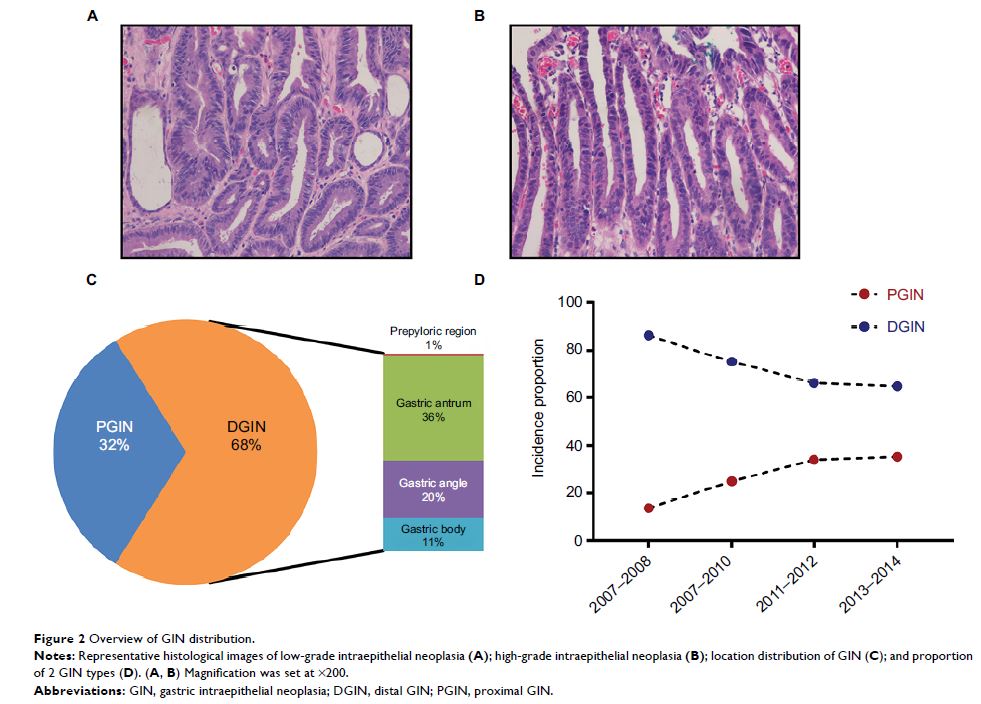9 0 5 7 8
论文已发表
注册即可获取德孚的最新动态
IF 收录期刊
- 2.6 Breast Cancer (Dove Med Press)
- 3.9 Clin Epidemiol
- 3.3 Cancer Manag Res
- 3.9 Infect Drug Resist
- 3.6 Clin Interv Aging
- 4.8 Drug Des Dev Ther
- 2.8 Int J Chronic Obstr
- 8.0 Int J Nanomed
- 2.3 Int J Women's Health
- 3.2 Neuropsych Dis Treat
- 4.0 OncoTargets Ther
- 2.2 Patient Prefer Adher
- 2.8 Ther Clin Risk Manag
- 2.7 J Pain Res
- 3.3 Diabet Metab Synd Ob
- 4.3 Psychol Res Behav Ma
- 3.4 Nat Sci Sleep
- 1.9 Pharmgenomics Pers Med
- 3.5 Risk Manag Healthc Policy
- 4.5 J Inflamm Res
- 2.3 Int J Gen Med
- 4.1 J Hepatocell Carcinoma
- 3.2 J Asthma Allergy
- 2.3 Clin Cosmet Investig Dermatol
- 3.3 J Multidiscip Healthc

中国成年人胃上皮内瘤变的危险因素:一项病例对照研究
Authors Yu Y, Fang C, Peng C, Shen S, Xu G, Sun Q, Li L, Su C, Zou X
Received 24 February 2018
Accepted for publication 22 May 2018
Published 13 August 2018 Volume 2018:10 Pages 2605—2613
DOI https://doi.org/10.2147/CMAR.S166472
Checked for plagiarism Yes
Review by Single-blind
Peer reviewers approved by Dr Andrew Yee
Peer reviewer comments 2
Editor who approved publication: Professor Luzhe Sun
Background: Gastric carcinoma (GC) is the third most frequent malignancy and
the second most common cancer-related cause of death cause worldwide. Gastric
intraepithelial neoplasia (GIN) is a well-documented precancerous lesion of GC.
In this case–control study, we comprehensively explored the clinical and
pathological characteristics of GIN, with the aim to identify its potential
risk factors.
Patients and
methods: A total of 630 consecutive patients
who underwent endoscopic submucosal dissection or mucosal resection for GIN
were initially included. The detailed characteristics of all eligible patients
and well-matched healthy controls were recorded and analyzed. Both univariate
and multivariate logistic regression analyses were performed and presented with
odds ratio (OR) and 95% confidential interval (CI), with additional subgroup
analyses based on lesion location.
Results: A total of 485 GIN-eligible patients were selected, among which
156 had proximal GIN. After follow-up, 434 patients with GIN and 310 age- and
gender-matched healthy controls were included in the comparative analyses.
Family cancer history (FCH); alcohol abuse; tobacco abuse; intake of high
sodium, preserved food, spicy food, and less fruit; Helicobacter pylori (Hp)
infection; and atrophic gastritis with intestinal metaplasia were more frequent
in GIN patients. Thus, FCH (OR =3.485, 95% CI: 2.031–5.981), high sodium intake
(OR =2.830, 95% CI: 1.645–4.868), less fruit intake (OR =4.082, 95% CI:
2.515–6.625), Hp infection (OR =2.307, 95% CI: 1.417–3.755), and atrophic
gastritis with intestinal metaplasia (OR =15.070, 95% CI: 8.999–25.237) were
independent risk factors for GIN. Further subgroup analyses demonstrated that
the specific independent risk factor for proximal GIN was age (OR =2.001, 95%
CI: 1.003–3.994), whereas that for distal GIN was intake of high sodium (OR
=3.467, 95% CI: 1.896–6.338).
Conclusion: This study reported a comprehensive overview of the clinical and
pathological characteristics of GIN. FCH, high sodium intake, less fruit
intake, Hp infection, and atrophic gastritis were identified as the independent
risk factors for GIN.
Keywords: gastric intraepithelial neoplasia, risk factor, case–control
study, subgroup analysis
